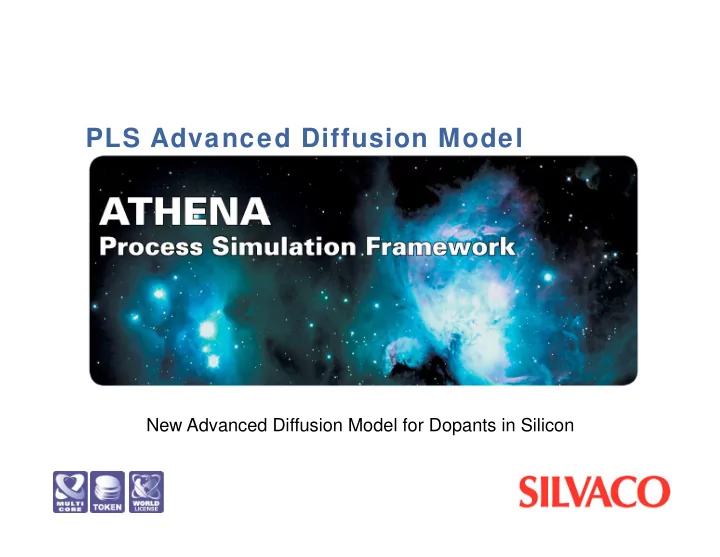

PLS Advanced Diffusion Model New Advanced Diffusion Model for Dopants in Silicon
Advanced Dopant Diffusion Model � � Introduction � � Why a new dopant diffusion model? � � PLS model � � Core diffusion model � � Interstitial clusters model � � Mixed Dopant/Defect Clusters model � � Results in 1D � � Results in 2D � � Conclusion and ongoing works - 2 - PLS Advanced Diffusion Model
Introduction � � PLS model was developed in close collaboration with CNRS- Phase, CEA-Leti and Silvaco France � � The idea was to have: � � A unique model for simulation of dopant diffusion and activation for advanced technologies � � A physical model � � One set of model parameters � � Accurate simulation of TED � � Easy to use, modular and flexible model - 3 - PLS Advanced Diffusion Model
Why a New Diffusion Model ? � � A high concentration of point defect created by the implantation step induces a fast acceleration of the diffusion (TED) � � What older model can simulate: � � Defect/dopant coupling diffusion � � Frenckel pair annihilation � � Recombination at the surface or in the bulk � � What older model cannot simulate: � � Defect clusters formation like <311> defects, dislocation loops… � � Mixed dopant/defect clusters like BIC, AsnV Modifies the defect evolution Induces an immobilization and and thus dopant diffusion inactivation of the dopant - 4 - PLS Advanced Diffusion Model
PLS Model � � One phenomena: one model � � PLS model = Three coupled models - 5 - PLS Advanced Diffusion Model
Core Diffusion Model � � Key Features: � � Physical Model based on Fick law and various reactions occurring during annealing � � Dopant migrates with the help of point defects � � Charge states for point defects and pairs dopant/defects are taken into account � � Recombination and exodiffusion at the surface � � Dynamic model for transient phenomena (ICs, BiC, AsnV ..) � � Dynamic simulation of dopant activation (solid solubility) - 6 - PLS Advanced Diffusion Model
Core Diffusion Model Results � � PLS model simulation of a pre-deposition which represents a meaningful test for advanced diffusion models � � PLS model is able to Boron reproduce the Arsenic characteristic profiles of each dopants Phosphorus - 7 - PLS Advanced Diffusion Model
Interstitial Cluster Model � � Key Features: � � Physical Model based on recent works done in the literature on Ostwald Ripening theory � � Various type of extended defects are taken into account: � � Small clusters � � <311> defects � � Perfect and faulted dislocation loops � � Ability to predict accurately the diffusion acceleration - 8 - PLS Advanced Diffusion Model
Interstitial Clusters Model Results � � PLS model simulation of Cowern experiment allows to predict accurately the evolution of silicon self- interstitial. This evolution controls the acceleration of the dopant diffusion (TED). - 9 - PLS Advanced Diffusion Model
Mixed Dopant/Defect Clusters Model � � Key Features: � � Physical Model based on recent ab-initio calculations � � For Boron, various type of BICs are possible: � � B2I and BI2 are precursors � � B3I and B4I2 are estimated to be more stable � � Arsenic Vacancy clusters AsnV � � Ability to easily add some new reactions in order to improve simulations - 10 - PLS Advanced Diffusion Model
Mixed Dopant/Defect Clusters Model � � PLS model simulation of Pelaz experiment allows to predict accurately the immobilization and the inactivation of boron. This is mainly due to the formation of mixed dopant/defect clusters (BIC) experimental setup: 800°C/30 min - 11 - PLS Advanced Diffusion Model
Full PLS Model Simulations on Implantation/ Diffusion � � PLS model simulation of boron diffusion after implantation at medium (20keV) and low (2keV) energy implantation Simulation of rapid thermal anneal Prediction of the inactivation of dopant at the concentration pic - 12 - PLS Advanced Diffusion Model
PLS Model in 2D Arsenic Boron Active arsenic Total arsenic Spike RTA 950C As-implanted Sims pro fi le Boron implanted at 2 keV – 10 14 cm -2 Arsenic implanted at 2 keV – 10 14 cm -2 and and annealed at 950 o C – 10s spike-annealed at 950 o C with a ramp up estimated at 100 o C/s. - 13 - PLS Advanced Diffusion Model
PLS Model in 2D Boron + Arsenic halo <311> defects - 14 - PLS Advanced Diffusion Model
Conclusion and Future Development � � Conclusion: � � Fully integrated in SILVACO tools � � Full physical model with ability to perform advanced simulations � � Possibility to easily add more equations to take into account more phenomena � � Ongoing development: � � Fully coupled with BCA implantation simulation with interstitial and vacancy profiles as initial conditions � � Taking into account other impurities such as Carbon or Fluorine � � Simulation of defect engineering: formation of Vacancy Clusters - 15 - PLS Advanced Diffusion Model
Recommend
More recommend